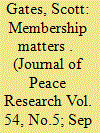| Srl | Item |
| 1 |
ID:
146151


|
|
|
|
|
| Summary/Abstract |
This article examines the impact of military unit composition on desertion in civil wars. I argue that military units face an increased risk of desertion if they cannot develop norms of cooperation. This is a challenging task in the context of divided and ambiguous individual loyalties found in civil wars. Norms of cooperation emerge, above all, from soldiers sending each other costly signals of their commitment. Social and factional ties also shape these norms, albeit in a more limited fashion. Hence, unit composition can serve as an intervening variable explaining how collective aims can sometimes induce individual soldiers to keep fighting. Analyzing original data from the Spanish Civil War (1936–1939), I demonstrate that three characteristics of a military unit's composition—the presence of conscripts rather than volunteers, social heterogeneity (whose effect is found to be limited to volunteer units), and polarization among factions—increase the individual soldier's propensity to desert. Unit composition proves at least as important as individual characteristics when explaining desertion. This analysis indicates the usefulness of moving beyond commonly used atomistic understandings of combatant behavior. Instead, it suggests the importance of theoretical microfoundations that emphasize norms of cooperation among groups of combatants.
|
|
|
|
|
|
|
|
|
|
|
|
|
|
|
|
| 2 |
ID:
155200


|
|
|
|
|
| Summary/Abstract |
Unable to attract enough voluntary recruits, many rebel groups rely on force to fill their ranks. Given that the group used force to compel individuals to join, a coerced conscript would be presumed unlikely to be loyal and would be expected to desert at the first opportunity. Yet, groups that have relied on coerced recruitment retain their members just as well as, if not better than, rebel armies that rely on voluntary methods of recruitment. This is a puzzle. How do rebel groups maintain allegiance and prevent desertion, especially if they rely on abduction to staff their ranks? A recruit can be forced to join a rebel group, but continuing to rely on coercion to enforce retention is too costly and not sustainable. These groups must find a way to reduce the costs of retention. The solution to this puzzle rests in the mechanisms of socialization that shape the allegiance of forcibly recruited soldiers. Socialization mechanisms are traced through three outcomes: compliance (or Type 0 socialization), role learning (Type I socialization), and norm internalization (Type II socialization). Integrating socialization theory and a rational choice analysis demonstrates that mechanisms that alter preferences through Type II socialization are effective in retaining recruits; the highest level of retention occurs when several mechanisms work in concert. Illustrative case studies of the Lord’s Resistance Army from Uganda, the Revolutionary United Front in Sierra Leone, the Maoists in Nepal, and the Liberians United for Reconciliation and Democracy (LURD) show that a reliance on child soldiers, group assets (pecuniary and non-pecuniary), organizational structure, and the nature of military contestation shape when different mechanisms are effective or not.
|
|
|
|
|
|
|
|
|
|
|
|
|
|
|
|
| 3 |
ID:
157850


|
|
|
|
|
| Summary/Abstract |
This article investigates the link between the organizational structure of nonstate armed groups and the ability of low-level combatants to desert without recapture. Throughout, I show that nonstate armed groups can adopt organizational structures that mimic those found in national armies and that are designed both to detect wannabe deserters and to facilitate the denunciation and recapture of those who manage to escape. The odds of a successful desertion are increased when territorial safe havens beyond the reach of these organizational structures are available. Three types of territorial safe haven are identified: (1) territory composed of rough terrain and/or free of nonstate armed groups and their informants; (2) United Nations (UN) bases and cantonment sites; and (3) other state and nonstate armed groups willing to accept deserters. These arguments are inductively developed from interviews with more than one hundred former members of nonstate armed groups in the Democratic Republic of Congo (DRC).
|
|
|
|
|
|
|
|
|
|
|
|
|
|
|
|